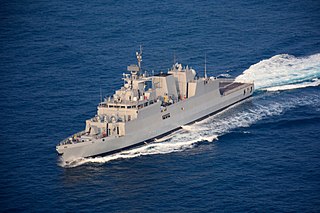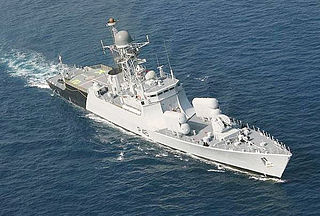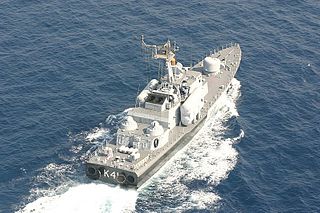
A corvette is a small warship. It is traditionally the smallest class of vessel considered to be a proper warship. The warship class above the corvette is that of the frigate, while the class below was historically that of the sloop-of-war. The modern types of ships below a corvette are coastal patrol craft, missile boat and fast attack craft. In modern terms, a corvette is typically between 500 tons and 2,000 tons, although recent designs may approach 3,000 tons, which might instead be considered a small frigate.

The Delhi-class destroyers are guided-missile destroyers of the Indian Navy. Three ships of this class are in active service. The Delhi-class vessels were the largest vessels to be built in India at the time of their commissioning. The ships were built by Mazagon Dock Limited (MDL) at a cost of ₹750 crore each.

INS Delhi is the lead ship of her class of guided-missile destroyers of the Indian Navy. She was built at the Mazagon Dock Limited in Mumbai and commissioned on 15 November 1997. This class is among the largest warships to be designed and built in India. The Ship was undergoing midlife upgrades from 2018. As of April 2022, she was back in service with Sensor upgrades and new 'Modular Launcher' for Brahmos Missile as a replacement for KH 35E. A Brahmos test was carried out from the ship on 19 April 2022.

The Rajput-class guided-missile destroyers built for the Indian Navy are modified versions of Soviet Kashin-class destroyers. They are also known as Kashin-II class. The ships were built in the former Soviet Union after considerable Indian design modifications to the Kashin design. These included the replacement of the helicopter pad in the original design with a flight elevator, as well as major changes to the electronics and combat systems. Five units were built for export to India in the 1980s. All units are currently attached to the Eastern Naval Command.
The Nilgiri-class frigates were updated versions of the Leander class, designed and built for the Indian Navy by Mazagon Dock Limited in Mumbai. Six ships were built between 1972–81. Vessels of the class formed the 14th Frigate Squadron. The lead ship INS Nilgiri was the first major warship to be built in India and was built in collaboration with Yarrow Shipbuilders of the United Kingdom.

The Godavari-class frigates were guided-missile frigates of the Indian Navy. The Godavari class was the first significant indigenous warship design and development initiative of the Indian Navy. Its design is a modification of the Nilgiri class with a focus on indigenous content of 72%, a larger hull and updated armaments. The class and the lead ship, INS Godavari were named after the Godavari River. Subsequent ships in the class, INS Ganga and INS Gomati also took their names from Indian rivers.

The Pauk class is the NATO reporting name for a class of small patrol corvettes built for the Soviet Navy and export customers between 1977 and 1989. The Russian designation is Project 1241.2 Molniya-2. These ships are designed for coastal patrol and inshore anti-submarine warfare. The design is the patrol version of the Tarantul class which is designated Project 1241.1, but is slightly longer and has diesel engines. The ships are fitted with a dipping sonar which is also used in Soviet helicopters.

The Kamorta-class corvettes or Project 28 are a class of anti-submarine warfare stealth corvettes currently in service with the Indian Navy. Built at Garden Reach Shipbuilders & Engineers (GRSE), Kolkata, they are the first anti-submarine warfare stealth corvettes to be built in India. Project 28 was approved in 2003, with construction of the lead ship, INS Kamorta commencing on 12 August 2005. All of the four corvettes, INS Kamorta, INS Kadmatt, INS Kiltan and INS Kavaratti were commissioned in 2014, 2016, 2017 and 2020 respectively.

The Minerva class is a series of corvettes of the Italian Navy. They were built in two batches of four units during the 1980s and 1990s. The ships have fairly good speed and armament, including a 76 mm general-purpose gun, but, due to their emphasis on anti-submarine warfare, they lack anti-ship missile capabilities. These units are designed to operate in coastal areas. Their main missions include sea policing, patrol, fisheries protection, and naval commando training. Four ships of this class are now active with Bangladesh Coast Guard as offshore patrol vessels (OPVs).

The Khukri-class corvette is a class of corvettes intended to replace the ageing Petya II-class corvettes of the Indian Navy.

The Car Nicobar class of high-speed offshore patrol vessels are built by Garden Reach Shipbuilders and Engineers (GRSE) for the Indian Navy. The vessels are designed as a cost-effective platform for patrol, anti-piracy and rescue operations in India's exclusive economic zone.

INS Khukri was the lead vessel of her class of corvettes, in service with the Indian Navy. The ship was named after INS Khukri, the only Indian Navy ship to be ever lost in combat.

The Saryu class of offshore patrol vessels (OPV) are advanced patrol ships of the Indian Navy built at the Goa Shipyard Limited. These vessels are capable of ocean surveillance and monitoring and can maintain control of shipping lanes. They can also be deployed to provide security to offshore oil installations, and other naval assets.
INS Abhay (P33) is the lead ship of her class of anti-submarine warfare corvettes, which are in service with the Indian Navy.

The Veer-class corvettes of the Indian Navy are a customised Indian variant of the Soviet Tarantul class. They form the 22nd Killer Missile Vessel Squadron.

INS Kiltan (P30) is an anti-submarine warfare corvette of the Indian Navy built under Project 28. It is the third of four Kamorta-class corvettes. The ship was built by the Garden Reach Shipbuilders and Engineers (GRSE), Kolkata, launched on 26 March 2013, and commissioned on 16 October 2017. Kiltan represents a leap forward in the Navy's attempts at localisation with as much as 90% of its content drawn from India itself.
The Anti-Submarine Warfare Shallow Water Craft (ASW-SWC) corvettes, are a class anti-submarine warfare vessels currently being built for the Indian Navy, by Cochin Shipyard (CSL) and Garden Reach Shipbuilders & Engineers (GRSE). They were conceived as a replacement to the ageing Abhay-class corvettes of the Indian Navy, and are designed to undertake anti-submarine warfare (ASW) duties – including subsurface surveillance in littoral-waters, search-and-attack unit (SAU) missions and coordinated anti-submarine warfare operations with naval aircraft. They were also designed to provide secondary duties – including defense against intruding aircraft, minelaying and search-and-rescue (SAR).

The Indian Navy has been focusing on developing indigenous platforms, systems, sensors and weapons as part of the nation's modernisation and expansion of its maritime forces. As of 2020 the Indian Navy has 43 vessels of various types under construction, including an aircraft carrier; destroyers; frigates; corvettes; and conventional-powered and nuclear-powered submarines and plans to build a strong navy of 200 vessels and 500 aircraft by 2050. In 2013 a senior naval official outlined the Indian Navy's intention to build a 200 ship navy over a 10-year period. According to Chief of Naval Staff's statement in December 2020, India has transformed from a buyer's navy to a builder's navy. All 41 ships under construction are being produced in Indian shipyards, both publicly and privately owned. However some projects have suffered from long delays and cost overruns.

INS Kavaratti (P31) is an anti-submarine warfare corvette of the Indian Navy built under Project 28. It is the last of four Kamorta-class corvettes. The ship was built by the Garden Reach Shipbuilders and Engineers, Kolkata, and launched on 19 May 2015. Kavaratti represents a leap forward in the Navy's attempts at indigenisation with as much as 90% of its content drawn from India itself. It was commissioned into the Navy on 22 October 2020 in Visakhapatnam.

INS Vagsheer (S26) is the sixth submarine of the first batch of six Kalvari-class submarines for the Indian Navy. It is a diesel-electric attack submarine based on the Scorpène class, designed by French naval defence and energy group Naval Group and manufactured by Mazagon Dock Limited, an Indian shipyard in Mumbai, Maharashtra. The ship was commissioned on 20 April 2022.
















